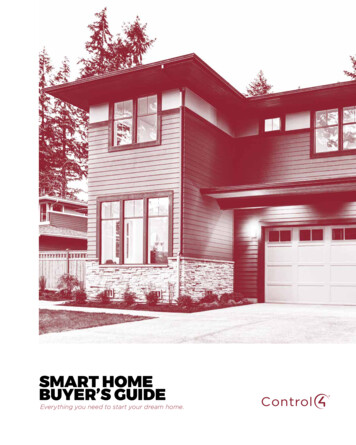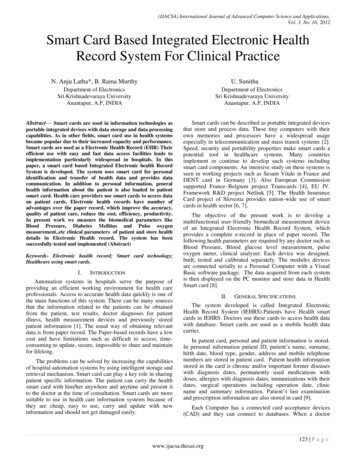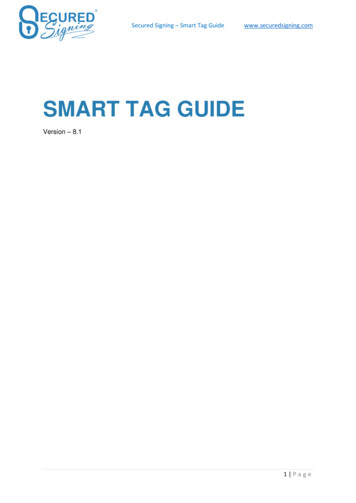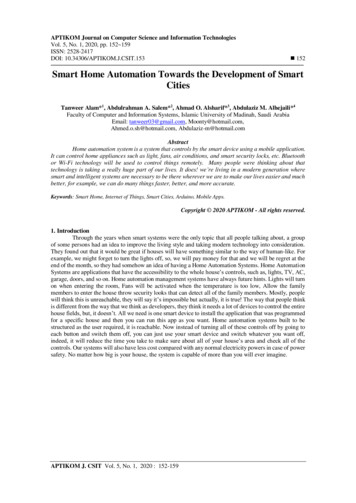
Transcription
SMART HELMETM OUNTED M OTORCYCLE P ROXIMITY S ENSOR WITH H ELMET D ISPLAYG ROUP 22J ULIAN B ONNELLS C OMPUTER E NGINEERINGJ ORGE D E G OUVEIA C OMPUTER E NGINEERINGJ EREMY R EIMERS E LECTRICAL E NGINEERINGB LAKE S CHERSCHEL C OMPUTER E NGINEERINGSenior Design I Project DocumentationDecember 6, 2016
TABLE OF CONTENTSList of Figures . viiList of Tables . ix1Executive Summary. 12Project Description. 22.1 Team member biographies . 22.1.1Julian Bonnells. 22.1.2Jorge De Gouveia . 22.1.3Jeremy Reimers . 32.1.4Blake Scherschel. 32.2Project Motivation and Goals . 42.3Objectives . 62.3.12.4Consumer demographics . 8Requirements Specifications . 92.4.1System Performance Requirements . 92.4.2BIKE-Mounted Module . 102.4.2.1Hardware Requirements . 102.4.2.2Software Requirements . 102.4.3Rear-Mounted Module . 112.4.3.12.4.4Heads-Up Display Module. 122.4.4.1Hardware Requirements . 122.4.4.2Software Requirements . 122.53Hardware Requirements . 11House of Quality Analysis . 12Research Related to Project Definition . 153.1 Existing Similar Projects and Products . 153.1.1SKULLY AR-1 Augmented Reality Helmet. 153.1.2NUVIZ Motorcycle Heads-Up Display. 163.1.3BMW Motorrad Vision Heads-Up Display. 183.1.4BikeHUD by BIKESYSTEMS . 193.2 Technologies Relevant to Project . 203.2.1Proximity Detection . 20i
3.2.1.1Lasers . 213.2.1.2Radio Waves . 213.2.1.3Ultrasound Waves . 223.2.1.4Infrared . 243.2.2Wireless Data Transmission . 253.2.2.1Wi-Fi . 253.2.2.2Bluetooth . 253.2.2.3ZigBee . 273.2.3Power Management . 283.2.3.1Bluetooth low energy . 283.2.3.2Battery Selection . 283.2.3.2.1 Alkaline . 293.2.3.2.2 Lithium-Ion . 303.2.3.2.3 Sealed Lead Acid . 303.2.3.2.4 Nickel-Metal Hydride . 313.2.3.3Battery Charger. 313.2.3.3.1 Lithium-Ion Charging Algorithm . 323.2.43.2.4.1LCD Display . 333.2.4.2LED Display. 333.2.4.3Transparent OLED Display . 343.2.4.4LCOS . 343.2.5Motorcycle Interface. 353.2.5.1On-Board-Diagnistics (OBD) . 353.2.5.2Dash LED Status Interception . 363.3Strategic Components and Part Selections . 373.3.1Proximity Detection . 373.3.1.1Sonar . 373.3.1.2LIDAR. 423.3.1.3Infrared . 443.3.2iiVisual Display . 32Wireless Data Transmission . 453.3.2.1Wi-Fi . 463.3.2.2Bluetooth . 47
3.3.2.33.3.3ZigBee . 48Power Management . 483.3.3.1Solar Power . 493.3.3.2Battery Power . 493.3.3.3Motorcycle Power Supply . 503.3.4Microcontrollers. 523.3.4.1Arduino . 533.3.4.2MSP430 . 543.3.4.3Raspberry Pi . 543.3.5Motorcycle Interface. 553.3.5.1On-Board-Diagnostics (OBD) . 553.3.5.2Dash LED Status Interception . 553.3.6Visual Display . 553.3.6.1LED Strip. 563.3.6.2OLED Non-transparent Screen . 563.4Summary of Selected Parts. 563.5Possible Architectures and Related Diagrams . 583.5.1 Proximity Sensor Helmet Architecture Draft . 583.5.2 Three Microcontroller System Architecture Draft . 593.5.3 Two Microcontroller System Architecture Draft . 604Related Standards & Design Constraints . 634.1 Standards . 634.2 Design Impact of Relevant Standards . 644.2.1Safety Standards . 644.2.2Bluetooth Communication . 644.2.3Lithium-Ion Rechargeable Battery . 644.2.4Programming Language Standards . 644.2.4.14.2.5Version Control . 65Arduino Development Guidelines . 654.2.4.1Naming Conventions . 664.2.4.2Function Formatting Conventions . 664.3 Economic and Time Constraints . 674.4 Environmental Constraints . 68iii
4.5 Safety and Health Constraints . 684.6 Manufacturability and Sustainability Constraints. 694.7 Scheduling concerns and time constraints . 695Project Hardware and Software Design Details . 715.1Initial Design Architecture and Related Diagrams . 715.2Bike-Mounted Motorcycle Interface Module. 735.2.1Subsystem Overview . 735.2.1.1Arduino ATmega MCU . 735.2.1.2Bluetooth Transmitter . 745.2.1.3Interface to motorcycle . 755.2.1.4Interface to proximity sensors. 775.2.1.5Power . 775.2.25.3Schematics and Simulation Test . 78Rear-Mounted Proximity Detection Module . 795.3.1Subsystem Overview . 795.3.1.1Proximity Sensors . 805.3.1.2Voltage Regulator . 815.3.1.3Interface to Bike-Mounted module . 825.3.2Schematics and Simulation Test . 825.3.2.15.4Helmet Heads-Up Display (HUD) Module . 845.4.1Subsystem Overview . 845.4.1.1Arduino Atmega MCU. 845.4.1.2Bluetooth Receiver . 855.4.1.3Visual Display . 865.4.1.4Power . 865.4.1.5Battery Charger. 865.4.1.6Audio Amplifier . 875.4.2Schematics and Simulation Test . 875.4.2.1Battery Charger. 875.4.2.2Audio Amplifier . 885.55.5.1ivVoltage Regulator . 82Software Design. 90Software Design Goals . 91
5.5.2Bike-Mounted Module Controller. 925.5.2.1Wireless Transmitter . 935.5.2.2Proximity Sensors . 945.5.3Helmet HUD ModuleController . 955.5.3.2Wireless Transmitter . 965.5.3.2Visual Display . 975.5.4 Software Libraries . 985.5.4.1 Visual Display . 995.5.4.2 Proximity Sensor . 995.5.4.3 Serial Network Connection . 1005.66Summary of Design. 101Project Prototype Construction and Coding . 1046.17Integrated Breadboard Test . 1046.1.1Battery Charger . 1046.1.2Audio Amplifier . 1056.1.3Voltage Regulator . 1066.1.4Proximity Sensor . 1086.2PCB Vendor and Assembly. 1096.3Final Coding Plan . 109Project Prototyping Testing Plan . 1107.1Hardware Test Environment . 1107.1.17.2Motorcycle Testing . 110Hardware Specific Testing . 1117.2.1MCU . 1117.2.1.1Wireless Data Transmission. 1127.2.2Proximity Sensors. 1147.2.3Power Supply . 1157.2.3.1Motorcycle Power . 1157.2.3.2Solar Power . 1157.2.5Visual Display . 1157.3Software Test Environment . 1167.4Software Specific Testing. 1177.4.1Arduino . 117v
7.4.1.1Visual Display . 1187.4.1.1.1 Visibility and Readability . 1187.4.1.2Proximity Sensor . 1197.4.1.2.1 Accuracy and Delay . 1197.4.1.2.2 Unit Conversion and Loss of Precision . 1207.4.1.2.3 Consolidating Multiple Readings . 1217.4.1.389Bluetooth Communication . 121Administrative Content . 1238.1Milestone Discussion . 1238.2Budget and Finance Discussion . 1258.3Bill of Parts Purchased . 127Conclusion . 129Appendices. 130Appendix A - Copyright Permissions . 130Appendix B - Datasheets . 133Appendix C – Software . 134Work Cited . 134vi
LIST OF FIGURESFigure 1: UNITED STATES MOTORCYCLE REGISTRATION IN 2014 BY STATE . 8Figure 2: House of Quality Analysis . 13Figure 3: SKULLY AR-1 TECHNICAL CONCEPT ART (CREDIT: SKULLY SYSTEMS 2014) . 15Figure 4: NUVIZ RIDE:HUD Concept Rendering (Credit: NUVIZ 2013) . 17Figure 5: BMW Mottorad Heads-Up Display Concept Rendering (Credit: BMW 2015) . 18Figure 6: BikeHUD Adventure (Credit: Bikesystem 2016) . 20Figure 7: Sound wave reflecting off the best case scenario object . 24Figure 8: ACI interface between application controller and BLE device . 27Figure 9: OBD-II WITH CAN SUPPORT PIN DIAGRAM . 36Figure 10: LZ-MAXSONAR -EZ1 BEAM PATTERN . 40Figure 11: Beam Width Testing Methodology . 41Figure 12: ESP-01 chip to USB serial pin configuration . 46Figure 13: ATMEGA328P PIN MAPPING . 53Figure 14: MSP430 PIN MAPPING . 54Figure 15: PROXIMITY SENSOR MOUNTED HELMET ARCHITECTURE DESIGN DIAGRAM 59Figure 16: THREE MICROCONTROLLER SYSTEM ARCHITECTURE DESIGN DIAGRAM . 60Figure 17: TWO MICROCONTROLLER SYSTEM ARCHITECTURE DESIGN DIAGRAM . 61Figure 18: HIGH LEVEL PROJECT BLOCK DIAGRAM . 72Figure 19: BIKE-MOUNTED MOTORCYCLE INTERFACE MODULE OVERVIEW . 73Figure 20: Cc2540 Bluetooth Low-Energy Serial module pin map (credit: evothings.com). 74Figure 21: Honda CB400F wires connecting to the LEDs . 75Figure 22: Interface circuit for motorcycle turn signal module . 76Figure 23: SIMULATED ADJUSTABLE LINEAR VOLTAGE REGULATOR CIRCUIT . 78Figure 24: REAR-MOUNTED PROXIMITY MODULE OVERVIEW . 80Figure 25: LV-MAXSONAR -EZ1 SERIES PIN MAPPING . 80Figure 26: SIMULATED ADJUSTABLE LINEAR VOLTAGE REGULATOR CIRCUIT . 83Figure 27: REAR-MOUNTED PROXIMITY MODULE OVERVIEW . 84Figure 28: Cc2540 Bluetooth Low-Energy Serial module pin map (credit: evothings.com). 85Figure 29: SIMULATED MCP73831 BATTERY CHARGING CIRCUIT . 88Figure 30: MCP73831-2 CHARGING CURRENT, BASED ON SWITCHES . 88vii
Figure 31: SIMULATED LM386 LOW-VOLTAGE AUDIO AMPLIFIER. 89Figure 32: LM386 VOLTAGE INPUT VS VOLTAGE OUTPUT (NOT TO SCALE) . 89Figure 33: BIKE-MOUNTED MOTORCYCLE INTERFACE SOFTWARE FLOW . 93Figure 34: PROXIMITY SENSORS SOFTWARE FLOW DIAGRAM . 95Figure 35: Helmet HUD module software flow . 96Figure 36: VISUAL DISPLAY SOFTWARE FLOW DIAGRAM . 98Figure 37: Received bytes to packet construction lifecycle. 101Figure 38: CONSTRUCTED MCP73831 BATTERY CHARGING CIRCUIT. 104Figure 39: MCP73831-2 CHARGING A 4.2V BATTERY OVER TIME . 105Figure 40: CONSTRUCTED LM386 LOW-VOLTAGE AUDIO AMPLIFIER . 106Figure 41: CONSTRUCTED LM7805 VOLTAGE REGULATOR CIRCUIT . 107Figure 42: CONSTRUCTED LV-MAXSONAR -EZ1 MB1010 CIRCUIT . 108Figure 43: DISTANCE VS. ACCURACY FOR MB1010 PROXIMITY SENSING . 108Figure 44: Visual Display Testing. 116Figure 45: ARDUINO, BLUETOOTH, PROXIMITY, AND VISUAL DISPLAY TESTING . 117Figure 46: Purchased Items (Part 1). 128Figure 47: Purchased Items (Part 2). 128viii
LIST OF TABLESTable 1: Project Objectives . 7Table 2: BATTERY TYPE COMPARISONS . 29Table 3: SMT 6500 Ranging Module specification summary . 38Table 4: LV-MAXSONAR -EZ SERIES SPECIFICATION SUMMARY. 39Table 5: LIDAR-LITE V3 SPECIFICATION SUMMARY . 43Table 6: SHARP GP2Y0A02YK0F SPECIFICATION SUMMARY . 44Table 7: WIRELESS COMMUNICATION TECHNOLOGY COMPARISON CHART . 45Table 8: MICROCONTROLLER SPECIFICATION COMPARISON CHART . 52Table 9: RELATED STANDARDS . 63Table 10: SIMULATED LM386 VOLTAGE REGULATOR OUTPUT With VARYING R2 . 79Table 11: SIMULATED LM7805 VOLTAGE REGULATOR OUTPUT WITH VARYING R2 . 83Table 12: AT-command sequence to set attributes on Helmet Bluetooth module . 93Table 13: AT-command sequence to set attributes on Helmet Bluetooth module . 96Table 14: CONSTRUCTED LM7805 VOLTAGE REGULATOR OUTPUT WITH VARYING R2 107Table 15: Honda Supersport CB400F specifications list. . 111Table 16: LOSSAGE TEST BASED ON DISTANCE IN HIGH NOISE ENVIRONMENT . 113Table 17: DATA SET SHOWING SHOWING MEDIAN THROWING OUT OUTLIERS. . 120Table 18: Sequence of partial packets being received . 122Table 19: INITIAL MILESTONES FOR SENIOR DESIGN 1 (PART 1) . 123Table 20: INITIAL MILESTONES FOR SENIOR DESIGN 1 (PART 2) . 124Table 21: INITIAL MILESTONES FOR SENIOR DESIGN 2 . 125Table 22: APPROXIMATE PROJECT BUDGET . 126Table 23: BILL OF PARTS. 127ix
1EXECUTIVE SUMMARYThe Smart Helmet system is planned to be a solution for any motorcycle rider that wishesto increase his or her awareness, and safety, while driving. The concept of proximitysensing in automobiles is not a new concept, and has been realized in different projects,and commercial products, before this one. However, such realizations tend to have theirown set of advantages and disadvantages associated with them. The design andimplementation of the Smart Helmet system seeks to maximize the advantages fromsimilar products, while avoiding, or minimizing, the disadvantages. What sets the SmartHelmet apart from existing products is the lower cost and ease of use to ensure anymotorcycle rider can afford and use it.The Smart Helmet system will be able to gather proximity information of surroundingobjects, using proximity sensors, to scan a wide field behind the rider, in order todetermine if other vehicles are close by. The system will draw power from the motorcycleand interpret electrical signals from the bike, such as signaling, speed, and othertachometer information. Data will be sent wirelessly from the motorcycle-mountedmodule and received by the helmet module. The helmet display will alert the rider if avehicle is too close to the motorcycle, and an audible tone will sound.In order to implement these features and bring the design to fruition, carefulconsideration was taken when selecting each hardware component. Because this projectdid not receive any third-party funding, cost was a limiting factor in our design. Thisfinancial consideration directly affected t
smart helmet mounted motorcycle proximity sensor with helmet display group 22 julian bonnells computer engineering jorge de gouveia computer engineering jeremy reimers electrical engineering blake scherschel computer engineering senior design i project documentation december 6, 2016










